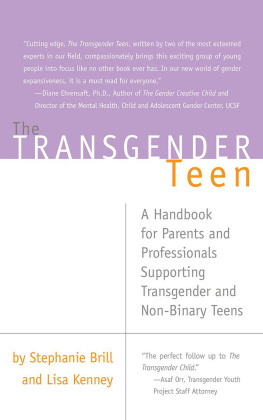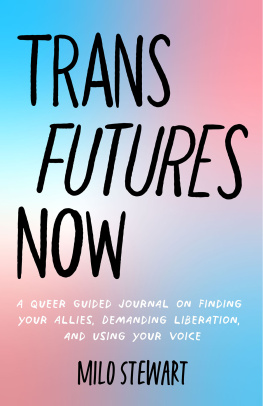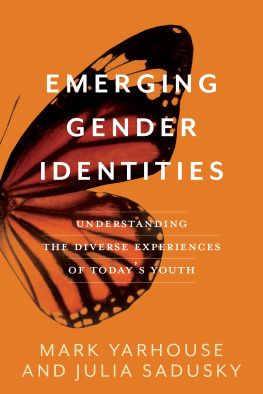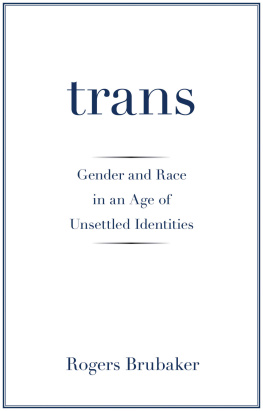
For Liam and all others with the courage to be themselves
Published in 2020 by The Rosen Publishing Group, Inc.
29 East 21st Street, New York, NY 10010
Copyright 2020 by The Rosen Publishing Group, Inc.
First Edition
All rights reserved. No part of this book may be reproduced in any form without permission in writing from the publisher, except by a reviewer.
Library of Congress Cataloging-in-Publication Data
Names: Lundquist-Arora, Stephanie, author.
Title: Coping with gender fluidity / Stephanie Lundquist-Arora.
Description: First edition. | New York: Rosen Publishing, 2020. | Series: Coping | Includes bibliographical references and index.
Identifiers: LCCN 2019009354| ISBN 9781725341265 (library bound) | ISBN 9781725341258 (pbk.)
Subjects: LCSH: Gender nonconformityJuvenile literature. | Gender identity Juvenile literature.
Classification: LCC HQ77.9 .L86 2020 | DDC 306.76/8dc23
LC record available at https://lccn.loc.gov/2019009354
Manufactured in the United States of America
On the cover: The concept of gender has moved beyond the binary man or woman categories. Rather, gender identities exist on a multidimensional and evolving continuum.
DISCLAIMER: Some of the images in this book illustrate individuals who are models. The depictions do not imply actual situations or events.
CONTENTS
INTRODUCTION
G ender identification is gaining more attention as an increasing number of teens identify as nonbinary or genderqueer, meaning outside the traditional binary of male and female. This boost is attributed to the growing comfort level teens have with self-expression, despite societal gender norms. One such example is Jaden Smith, the American rapper, actor, and son of Will Smith and Jada Pinkett-Smith. Smith is not shy in expressing his gender nonconformity. He went to his high school prom in a dress and modeled womens clothing for a Louis Vuitton campaign.
The media and entertainment industries also embrace the gender-fluidity representation. Fictional characters express their nonbinary gender identities in books, movies, and television shows. Real-life role modelssuch as American entertainer Miley Cyrus, Australian entertainer Ruby Rose, British actor Tilda Swinton, British musician Pete Townshend, Brazilian model Lea T, and Canadian author Rae Spoonshare their personal experiences and expressions in news stories, social media posts, and interviews.
Nonbinary gender identification has existed throughout history and around the world. The hijra community in India, which is made up of individuals who do not identify as male or female, dates back to the second century. India officially recognized hijra as a third gender in 2014. Similarly, the travesti in Latin America are viewed as people who are concurrently men and women and are also considered to be a third gender. The waria of Indonesia are assigned male at birth and grow to experience life as women. Variations of the two-spirit people, those with a masculine and a feminine spirit, have been documented in Siberia, New Zealand, the Democratic Republic of the Congo, and among the Navajo Nation in the American Southwest. Fast-forwarding to the twenty-first century, Canada has committed to adding a third non-binary gender option to its 2021 census to be more inclusive of its gender-fluid citizens.
Despite the long history of nonbinary gender identification and modern-day awareness, matters of gender identity remain contentious and oversimplified. Some have claimed that the media has reduced transgender rights activism to nongendered bathrooms and locker rooms. Public policies surrounding fair bathroom use has stirred up transphobic rhetoric among segments of the population and do not automatically equate to fair treatment. While some American states have passed equal access laws, there are some that have not. In addition, gender nonbinary teens are still more likely to attempt suicide and/or experience isolation, bullying, low self-esteem, homelessness, gender dysphoria, and depression than their cisgender (those who have the same internal sense of gender as the gender they were assigned at birth) counterparts. Despite the many challenges, there are many ways to cope with gender fluidity when embarking on and supporting the gender-exploration journey.

Tilda Swinton, who identifies as gender-fluid, is one of many entertainers who publicly embrace a nonbinary gender identity.
CHAPTER ONE
What Is Gender Fluidity?
G ender-fluid describes a person who floats between the masculine and feminine ends of the continuum, either slowly over time or at any given point, depending on individual, social, and/or cultural preferences. The term first appeared in the 1980s and is used to describe a nonbinary gender that does not simply check off a male box or female box. Rather, gender fluidity is a continuum with multiple dimensions, as if drawing a line to connect the boxes.
There is limited data on how many teens identify as gender-fluid. A study published in March 2018 in the journal Pediatrics suggests that nearly 3 percent of the respondents identified as transgender, genderqueer, gender-fluid or unsure of your gender identification. This was an increase from the 0.7 percent identifying as transgender, as noted in a UCLA study conducted the year prior. The 2015 US Transgender Survey, by the National Center for Transgender Equality, reports that at least 25 to 35 percent of the transgender population identifies as a nonbinary gender. This includes bigender (those with two genders), gender-fluid, genderqueer, and agender (those with no gender).

Gender-fluid people float between the masculine and feminine ends of the gender continuum. Gender presentation might fluctuate on a daily basis.
The Meaning of Gender
In the mid-twentieth century, many people believed that your role, appearance, and behavior were determined largely by your gender assignment at birth. Ideas of gender almost exclusively supported a cisgender world. If you were female, you identified as a woman and presented yourself in feminine ways. A woman was expected to marry a man, wear dresses and pearls, raise children, cook meals for her family, and tend to the needs of the home. If you were male, you identified as a man and presented yourself in masculine ways. You were expected to earn money to support the family, wear suits, and enjoy sports and hunting. Even though gender fluidity existed during this time, it was not culturally supported or recognized among the general population.
Over time, especially with the rise of the second wave of feminism in the latter half of the twentieth century, voices grew louder in objection to the rigid, unfair, and inaccurate view of gender. Feminist scholars such as Betty Friedan and Simone de Beauvoir focused on the expected roles of women in society, noting that women were just as capable outside of the home as men. Similarly, men were capable of cooking, cleaning, and caring for a family inside the home. This new point of view began to revolutionize the way people defined woman and man.
A third wave of feminist thinking came in the 1990s, which shifted away from the binary classification of gender in favor of a broader conceptualization. Gender theory scholar Judith Butler argued that gender is independent of biological sex. She writes in her book
Next page












